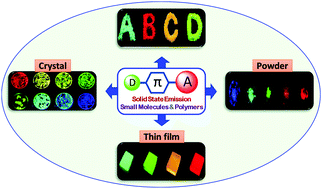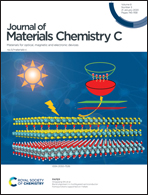Solid-state emissive organic chromophores: design, strategy and building blocks
Abstract
Organic solid-state emissive materials have gained much attention in recent times due to their excellent optoelectronic properties leading to successful commercialization for organic electronics. But achieving highly efficient solid-state emission (fluorescence) from organic chromophores is not an easy task because of molecular aggregation which leads to quenching of emission. However, several strategies have been developed to generate efficient fluorescence emission in the solid state by suppressing the undesired molecular aggregation. In this review, first an overview on various designs and strategies of molecular building blocks for making solid-state emissive organic chromophores is presented. Among various strategies, the selection is focused on the use of either partially or fully twisted molecular building blocks or introduction of bulky substituents or employing a donor–acceptor type system, which can effectively reduce the intermolecular π–π stacking interaction and produce fluorescence emission in the solid state with high quantum yield. In this context, tuning and controlling of the fluorescence properties based on a single molecular building block is attractive to realize multicoloured emission and more advantageous for blending of different fluorescent materials in light emitting devices. In the second part, we illustrate several examples of colour tunable solid-state emissive organic materials that have been developed using a single molecular building block.

- This article is part of the themed collection: Journal of Materials Chemistry C Recent Review Articles


 Please wait while we load your content...
Please wait while we load your content...